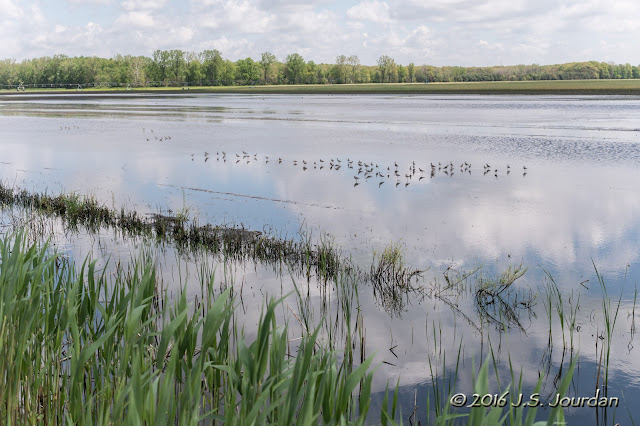Curlew Sandpiper in Ohio! - 13 May 2016
The curlew sandpiper breeds on the tundra in Siberia and Alaska. It is a highly migratory bird that winters in areas from western Europe and southern Asia to southern Africa and Australia. A highly gregarious bird, it occasionally wanders into North America, with regular sightings mainly in Alaska and Hawaii, but sometimes even farther south to our region.
The birds would flush and scatter, but not before circling in front of us before landing farther out into the field. That would be my queue to pack up and head back to work. This bird would provide some nice consolation for someone unable to participate in this spring's migration spectacle due to work obligations...
Angola Rd and Raab Rd Curlew Sandpiper, Lucas, Ohio, US
May 13, 2016 12:00 PM - 1:00 PM
Protocol: Stationary
Checklist Comments: Code 3 Curlew Sandpiper in Swanton, OH
5 species
Short-billed Dowitcher (Limnodromus griseus) 1 Adult bird shows heavy spotting on throat in contrast to L. hendersonii. Chest is orange but belly / vent area is white (expect uniform orange belly and chest). See photo.
Wilson's Phalarope (Phalaropus tricolor) 1
Lesser Yellowlegs (Tringa flavipes) 16
Curlew Sandpiper (Calidris ferruginea) 1 Excerpt from full blog post at: https://birdingthroughglass.bl
Yesterday, Steve Jones stumbled upon an ABA Code 3 Curlew Sandpiper at the corner of Angola and Raab Rds in Swanton, OH. The Code 3 status means that only 1 or 2 birds are seen annually in North America, and that fact that this bird was found in breeding plumage made it even more special. Luck also brought the bird close enough for some wonderful photos, and luck also kept it around for several days. So, I did what any dedicated employee would do - I skipped out of work and headed out to see it, myself!
The bird was seen among a flock of Dunlin and Lesser Yellowlegs in a flooded field field in a rural part of NW Ohio. The fact that it was also found during the Biggest Week in American Birding Festival meant that hundreds of birders flocked to see it. I was fortunate to arrive just before noon Friday and see dozens of birders lined along the banks of Angola Rd. scoping and photographing the bird just 40 feet away. "You don't even need binoculars, the bird is that close" they replied when I inquired.
I even managed to capture its wing-stretch, which allowed me to see its bright white underwings.
Photos
Dunlin (Calidris alpina) 6
View this checklist online at https://ebird.org/checklist/S1
This report was generated automatically by eBird v3 (https://ebird.org/home)


























I saw this bird amongst the lesser yellow legs on that flooded field too!. It was my birthday, and I was with the Cincinnati Nature centre group led by Bill Creasy- a great life list bird for me!!!
ReplyDeleteCJZ
I saw this bird amongst the lesser yellow legs on that flooded field too!. It was my birthday, and I was with the Cincinnati Nature centre group led by Bill Creasy- a great life list bird for me!!!
ReplyDeleteCJZ
I saw this bird amongst the lesser yellow legs on that flooded field too!. It was my birthday, and I was with the Cincinnati Nature centre group led by Bill Creasy- a great life list bird for me!!!
ReplyDeleteCJZ